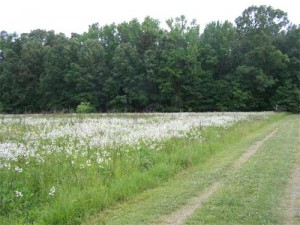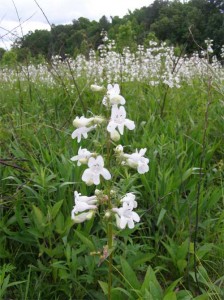In the footsteps of John Terres at Mason Farm
By Ken Moore
Mason Farm’s penstemon fields are more spectacular this year than ever. The N.C. Botanical Garden’s careful management – a combination of select mowing and prescribed burning, simulating nature – encourages these impressive seasonal wildflower displays.
Each time I visit the Mason Farm Biological Reserve south of Finley Golf Course, I make new discoveries. Every visit makes me cherish the proximity of such an extensive wild area.
Editor of Audubon magazine John K. Terres fell under the spell of Mason Farm back in 1961, when he retreated to Chapel Hill from New York City to take on an assignment to write an encyclopedia of North American birds. Fortunately, he was introduced to Mason Farm soon after his arrival. Being a naturalist accustomed to daily forays into the wild, Mason Farm gave Terres a place for breaks from his indoor labors — a place to renew his energies and spirit.
The description of his first visit to the farm is memorable:
“I first saw the Mason Farm of the University of North Carolina at Chapel Hill in February 1961.… Crossing Morgan Creek over a concrete dam, I walked under the winter sun on a road that led over a grass-grown levee, built to hold back the spring floods. I had no thought of what might lie beyond. When I reached the top of the dike, I gasped. For two miles straightaway, and from east to west, windswept fields and woods lay under an enormous vault of blue.
A thousand acres of swamps and fields and forests, to as far as I could see, were suddenly opened before me – a vast freedom of land and sky. The farm, only two miles southeast of Chapel Hill, a city of 30,000, was near, yet isolated, a land few people knew. As I penetrated its old roads, I felt its loneliness that I was to know by day through silences broken only by a hawk’s screaming or the shouting of crows and by night through the moaning of owls and the barking of half-wild dogs and foxes. This was a wilderness of the land to match the wilderness of the heart.â€
You just can’t paraphrase that; John’s writing is that good!
For the next eight years, he roamed the fields and forests of Mason Farm day and night.
His written observations of the farm’s natural history rivaled his progress on the encyclopedia. Encouraged and supported by friends and publishers, a narrative of his Mason Farm adventures, From Laurel Hill to Siler’s Bog: The Walking Adventures of a Naturalist was published in 1969, years before he completed that encyclopedia.
Viewing the penstemon fields last week, I walked in reverence, following John’s footsteps everywhere. I paused frequently, as he must have, to wonder at the sea of penstemons before me.
I call this penstemon Penstemon laevigatus, eastern beardtongue. Others insist it is P. digitalis, tall white beardtongue. Since it has characteristics of both species, it makes for engaging conversation whenever botanist types get together.

Vast penstemon fields are just one of the attractions of a walk around Mason Farm. Photo by Ken Moore
Whatever it’s called, it also makes a handsome garden plant. This penstemon is available at the Botanical Garden. You will enjoy growing it almost as much as seeing those fields, almost as much as reading John’s walking adventures around the farm.
The Botanical Garden has scheduled a “From Laurel Hill to Siler’s Bog: In the footsteps of John Terres†walk this weekend. There may still be time to register for it by calling 962-0522.



Trackbacks and Pingbacks
Comments are closed.